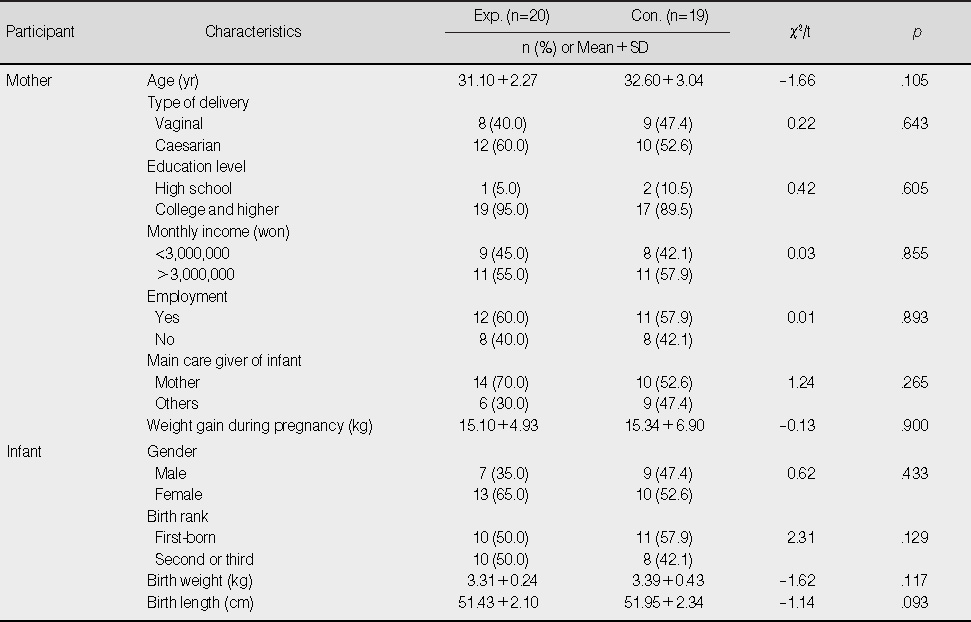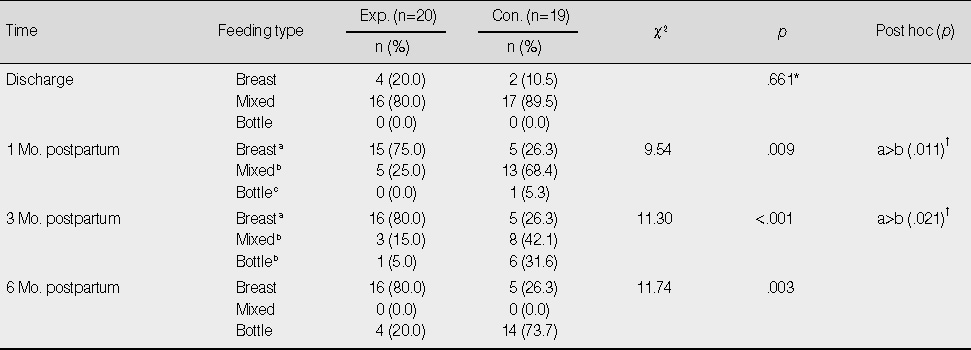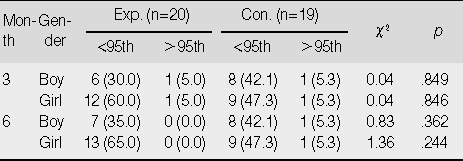Articles
- Page Path
- HOME > J Korean Acad Nurs > Volume 40(2); 2010 > Article
-
Original Article
- Effects of Breast-feeding Education and Support Services on Breast-feeding Rates and Infant's Growth
- Gun-Ja Jang, Sun-Hee Kim
-
Journal of Korean Academy of Nursing 2010;40(2):277-286.
DOI: https://doi.org/10.4040/jkan.2010.40.2.277
Published online: April 30, 2010
1Full-time Lecturer, Department of Nursing, Daegu Haany University, Daegu, Korea.
2Head Nurse, Kyungpook National University Hospital, Daegu, Korea.
- Address reprint requests to: Jang, Gun-Ja. Department of Nursing, Daegu Haany University, 165 Sang-dong, Suseong-gu, Daegu 706-828, Korea. Tel: 82-53-650-8391, Fax: 82-53-650-8389, kjjang14@daegu.ac.kr
Copyright © 2010 Korean Society of Nursing Science
Abstract
-
Purpose
- This study was done to investigate the effects of breast-feeding education and support services on rate of breast-feeding three and six months after birth, and the effect on infant's growth (weight, height, body mass index [BMI]). The experimental group which had both education and support services was compared with the control group which had only breast-feeding education.
-
Methods
- This study was a quasi-experimental study with a time-series design. The participants were 39 mothers who were hospitalized for childbirth. Twenty mother were assigned to the experimental group and 19 mothers, to the control group. The breast feeding education was done during hospitalization, and support services were provided once a week after discharge for a month (a total 4 times) by a maternity ward nurse. Data regarding breastfeeding rate at one month after childbirth was collected by phone call; the breast-feeding rates at three and six months after childbirth were collected in a visit to the families. The child's weight and height were also measured during the visit.
-
Results
- The experimental group had a statistically significant higher rate for frequency of breast-feeding at one, three and six months after childbirth than the control group. However, there was no meaningful difference between the two groups for infant growth.
-
Conclusion
- The results of this study suggest that breast-feeding education is helpful for a start, but support services are also necessary to sustain breast-feeding.
- 1. Baker JL, Michaelsen KF, Rasmussen KM, Sorensen TI. Maternal prepregnant body mass index, duration of breast feeding, and timing of complementary food introduction are associated with infant weight gain. American Journal of Clinical Nutrition. 2004;80:1579–1588.ArticlePubMed
- 2. Chin LY, Amir LH. Survey of patient satisfaction with the breast feeding education and support services of the Royal Women's Hospital, Melbourne. BMC Health Services Research. 2008;14(8):1–11.
- 3. Cho HC. The Effect of breast-feeding promotion program on the primipara's breastfeeding. 2007;Suwon, Ajou University. Unpublished master's thesis.
- 4. Grummer-Strawn LM, Mei Z. Does breast-feeding protect against pediatric overweight? Analysis of longitudinal data from the centers for disease control and prevention pediatric nutrition surveillance system. Pediatrics. 2004;113:e81–e86.ArticlePubMedPDF
- 5. Harder T, Bergmann R, Kallischnigg G, Plagemann A. Duration of breastfeeding and risk of overweight: A meta-analysis. American Journal of Epidemiology. 2005;162:397–403.ArticlePubMed
- 6. Hediger ML, Overpeck MD, Kuczmarski RI, Ruan WJ. Association between infant breastfeeding and overweight in young children. The Journal of the American Medical Association. 2001;285:2453–2460.ArticlePubMed
- 7. Hwang WJ. The study on the factors determining breastfeeding rate and duration. 2004;Seoul, Yonsei University. Unpublished master's thesis.
- 8. Im YS. A study on the factors influencing infant's obesity based on infant feeding and weaning practice. 2000;Seoul, Yonsei University. Unpublished master's thesis.
- 9. Jacknowitz A. Increasing breastfeeding rates: Do changing demographics explain them? Womens Health Issues. 2007;17:84–92.ArticlePubMed
- 10. Jang GJ, Kim SH, Jeong KS. Effect of postpartum breast-feeding support by nurse on the breast-feeding prevalence. Journal of Korean Academy of Nursing. 2008;38:172–179.ArticlePubMed
- 11. Jeong GH. Effect of the nursing intervention program on promotion the breast-feeding practice in primipara. 1997;Seoul, Ewha Womans University. Unpublished doctoral dissertation.
- 12. Kim KA, Shin SM, Lee K. Evaluation of the effect of BFHI (Baby-Friendly Hospital Initiative) developed by WHO/UNICEF. Korean Journal of Perinatology. 2005;16:37–48.
- 13. Kim SH. The relationship between breast-feeding and childhood obesity. 2004;Seoul, Yonsei University. Unpublished master's thesis.
- 14. Kim SH. Development of a breast feeding adaptation scale (BFAS). Journal of Korean Academy of Nursing. 2009;39:259–269.ArticlePubMed
- 15. Korean Committee for UNICEF. 2004 Korean committee for UNICEF: Annual report. 2005;Retrieved February 20, 2008. from http://unicef.or.kr/unicef/board_book/upload/2004_ar_KCU_Ko.pdf.
- 16. Kramer MS, Matush L, Vanilovich I, Platt RW, Bogdanovich N, Sevkovskaya Z. Effects of prolonged and exclusive breastfeeding on child height, weight, adiposity, and blood pressure at age 6.5 y: Evidence from a large randomized trial. American Journal of Clinical Nutrition. 2007;86:1717–1721.ArticlePubMed
- 17. Kwak JY, Park JY, Lee HJ, Jung HJ, Son SH, Jung SJ. Growth patterns of breast fed and formula fed infants. Korean Journal of Pediatrics. 2005;48:1055–1060.
- 18. Moon JS, Lee SY, Nam CM, Choi JM, Choe NK, Seo JW, et al. 2007 Korean national growth charts: Review of developmental process and an outlook. Korean Journal of Pediatrics. 2008;51:1–25.Article
- 19. Oh KW, Jang MJ, Lee NY, Moon JS, Lee CG, Yoo MH, et al. Prevalence and trends in obesity among Korean children and adolescents in 1997 and 2005. Korean Journal of Pediatrics. 2008;51:950–955.Article
- 20. Owen CG, Martin RM, Whincup PH, Smith GD, Cook DG. Effect of infant feeding on the risk of obesity across the life course: A quantitative review of published evidence. Pediatrics. 2005;115:1367–1377.ArticlePubMedPDF
- 21. Park EY, Cho SJ, Lee K. Current understanding and practices of breast feeding by mothers. Korean Journal of Pediatrics. 2005;48:1162–1165.
- 22. Park SH. The effect of breast-feeding education and follow-up care on the breast-feeding rate and the breast-feeding method: Focused on home visit and phone counseling. 2001;Daegu, Keimyung University. Unpublished master's thesis.
- 23. Park YR. The Effect of the integrated breast-feeding education on the knowledge, the adhesiveness and the attitude on breastfeeding. 2005;Incheon, Inha University. Unpublished master's thesis.
- 24. Salsberry PJ, Reagan PB. Dynamics of early childhood overweight. Pediatrics. 2005;116:1329–1338.ArticlePubMedPDF
- 25. Seo IS, Jung MS, Suh YS. Effect of education for encouraging breast feeding on practice of breastfeeding. Korean Journal of Women Health Nursing. 2000;6:632–642.ArticlePDF
- 26. Sohn IA. A study on the factors affecting knowledge about, attitudes towards and practice of breast-feeding. 2007;Seoul, Hanyang University. Unpublished master's thesis.
- 27. World Health Organization. The Optimal Duration of Exclusive Breast-Feeding: A systemic review. 2002;Geneva, Author.
- 28. World Health Organization. WHO Child Growth Standards. 2006;Retrieved February 2, 2008. from http://www.who.int/childgrowth/en.
- 29. Yeo JH. Influencing factors in breast feeding duration. Korean Journal of Women Health Nursing. 2005;11:142–147.ArticlePDF
- 30. Yoo EK, Kim MH, Seo WS. A study on the role of breast-feeding practice by education and continuous telephone follow-up. Korean Journal of Women Health Nursing. 2002;8:424–434.
REFERENCES
Figure & Data
REFERENCES
Citations

- Support for healthy breastfeeding mothers with healthy term babies
Anna Gavine, Shona C Shinwell, Phyll Buchanan, Albert Farre, Angela Wade, Fiona Lynn, Joyce Marshall, Sara E Cumming, Shadrach Dare, Alison McFadden
Cochrane Database of Systematic Reviews.2022;[Epub] CrossRef - Effects of an Infant Care Education Program for Mothers of Late-preterm Infants on Parenting Confidence, Breastfeeding Rates, and Infants' Growth and Readmission Rates
Eun Hye Jang, Hyeon Ok Ju
Child Health Nursing Research.2020; 26(1): 11. CrossRef - Knowledge of and Attitude toward Breastfeeding among Medical Staff Working in the Neonatal Intensive Care Unit and Obstetric Unit
Eun Sook Kim, Young Hee Cho, Hyejung Lee
Journal of The Korean Society of Maternal and Child Health.2020; 24(2): 102. CrossRef - Effects of Breastfeeding Interventions on Breastfeeding Rates at 1, 3 and 6 Months Postpartum: A Systematic Review and Meta-Analysis
Seol Hui Park, Seang Ryu
Journal of Korean Academy of Nursing.2017; 47(6): 713. CrossRef - Pengaruh Pendidikan Kesehatan dengan Lembar Balik Terhadap Perilaku Pemberian Asi pada Ibu Post Partum
Luluk Fajria Maulida
Jurnal Kebidanan Midwiferia.2017; 3(2): 40. CrossRef - Belief factors associated with breastfeeding intentions of single women: Based on the theory of planned behavior
Min Kyung Jang, Seung-Min Lee, Jin Mo Khil
Journal of Nutrition and Health.2017; 50(3): 284. CrossRef - Support for healthy breastfeeding mothers with healthy term babies
Alison McFadden, Anna Gavine, Mary J Renfrew, Angela Wade, Phyll Buchanan, Jane L Taylor, Emma Veitch, Anne Marie Rennie, Susan A Crowther, Sara Neiman, Stephen MacGillivray
Cochrane Database of Systematic Reviews.2017;[Epub] CrossRef - Prevalence and Predictors of Exclusive Breastfeeding in Late Preterm Infants at 12 Weeks
Soo Yeon Lee, Gun Ja Jang
Child Health Nursing Research.2016; 22(2): 79. CrossRef - The Effect of Education Based on Health Belief Model on Breastfeeding of First Pregnant Mothers Referred to Hospital Imam Reza
Roya Amini, Elham Moayeri, Masoud Khodaveisi, Alireza Soltanian, Firozeh Veisi
Journal of Pediatric Nursing.2016; 3(2): 17. CrossRef - Enhancing Neonatal Wellness with Home Visitation
Carlo Parker, Geene Warmuskerken, Lorna Sinclair
Nursing for Women's Health.2015; 19(1): 36. CrossRef - Breastfeeding Initiation and Continuation by Employment Status among Korean Women
Nam Mi Kang, Jung Eun Lee, Yeon Bai, Theo Van Achterberg, Taisun Hyun
Journal of Korean Academy of Nursing.2015; 45(2): 306. CrossRef - Development and Evaluation of Breastfeeding Promotion Program for Mothers with Breast Engorgement following Cesarean Birth
Jeongsug Cho, Sukhee Ahn
Journal of Korean Academy of Nursing.2014; 44(2): 170. CrossRef - Comparison of Lactation Problems, Knowledge, and Adaptation on Breastfeeding between Users and Non-Users of Lactation Clinic
Myoung Hee Yun, Hye Sook Shin
Journal of East-West Nursing Research.2014; 20(2): 112. CrossRef - Maternal Psychosocial Factors that Affect Breastfeeding Adaptation and Immune Substances in Human Milk
Eun Sook Kim, Mi Jo Jeong, Sue Kim, Hyun-A Shin, Hyang Kyu Lee, Kayoung Shin, Jee Hee Han
Korean Journal of Women Health Nursing.2014; 20(1): 14. CrossRef - Comparison of breast feeding practice rates and mothers' breast feeding empowerment in preterm, late preterm and early term infants
Taeim Kim, Gunja Jang
Journal of the Korean Data and Information Science Society.2013; 24(4): 713. CrossRef - Breast Feeding Rates and Factors Influencing Breast Feeding Practice in Late Preterm Infants: Comparison with Preterm Born at Less than 34 Weeks of Gestational Age
Gun Ja Jang, Sang Lak Lee, Hyeon Mi Kim
Journal of Korean Academy of Nursing.2012; 42(2): 181. CrossRef - Improvements of Behavior and Attitude of Pregnant Women Trained by A Maternity-oriented Antenatal Education Program: Assessment of Korean Gentle Birth (KGB) Program
김영란, 장우식, Sohn,Hae-Sook, 전채민, Chun Jin Ho, 민유선, 남문희
JOURNAL OF THE KOREAN SOCIETY OF MATERNAL AND CHILD HEALTH.2012; 16(2): 227. CrossRef - Exclusive Breastfeeding Rates of Breastfeeding-Willing Mothers and Its Influencing Factors by the 1st, 3rd, and 6th Month of Postpartum
이선옥, Kyung-Yeon Park, 나성순
JOURNAL OF THE KOREAN SOCIETY OF MATERNAL AND CHILD HEALTH.2012; 16(1): 44. CrossRef - Effects of Self-breast Pumping in Primiparous Women after Cesarean Delivery
Jung Hee Yeo, Guil Nam Moon, Sun-Ok Lee
Korean Journal of Women Health Nursing.2012; 18(2): 98. CrossRef
Homogeneity test for General Characteristics of Participants (N=39)
Exp.=experimental group; Con.=control group.
Homogeneity test for Characteristics of Breast-feeding (N=39)
Exp.=experimental group; Con.=control group.
Comparison of Breast feeding Prevalence between the two groups (N=39)
* Fisher's exact test; † post-hoc comparison was conducted by bonferroni adjustment after χ2-test.
Exp.=experimental group; Con.=control group; Mo.=month.
Comparison of Infant Growth and BMI over time between the two groups (N=39)
Exp.=experimental group; Con.=control group; Mo.=month; BMI=body mass index.
Comparison of overweight infants between the two groups
Exp.=experimental group; Con.=control group.
Exp.=experimental group; Con.=control group.
Exp.=experimental group; Con.=control group.
* Fisher's exact test; † post-hoc comparison was conducted by bonferroni adjustment after χ2-test. Exp.=experimental group; Con.=control group; Mo.=month.
Exp.=experimental group; Con.=control group; Mo.=month; BMI=body mass index.
Exp.=experimental group; Con.=control group.
 KSNS
KSNS
 E-SUBMISSION
E-SUBMISSION





 Cite
Cite

